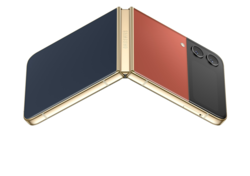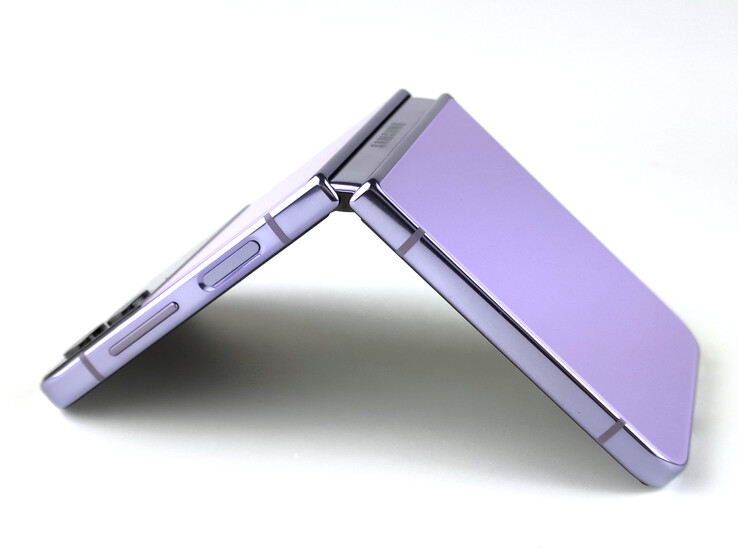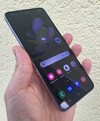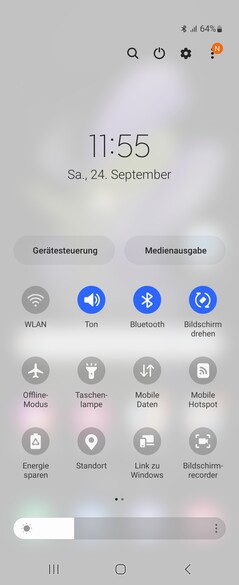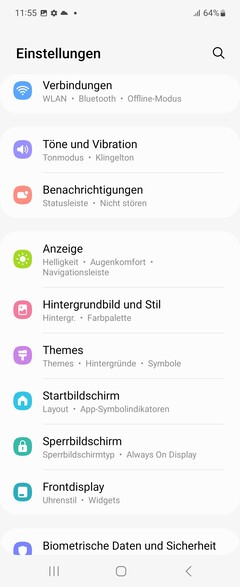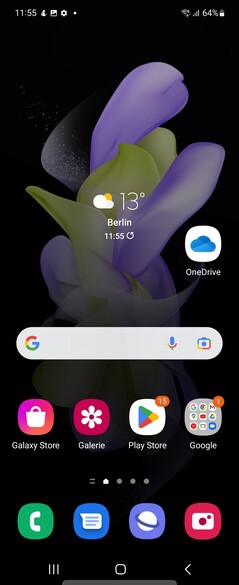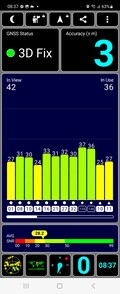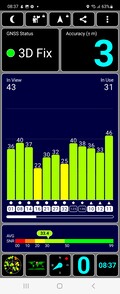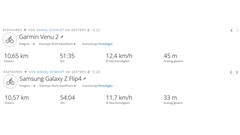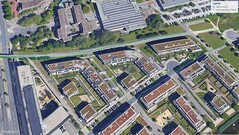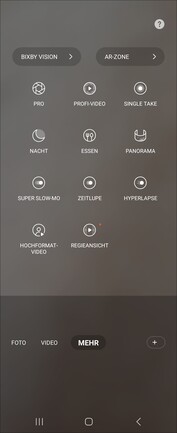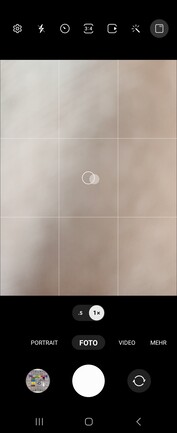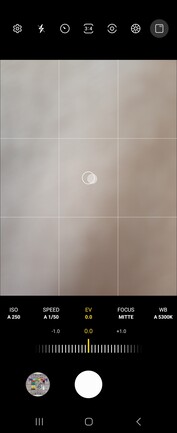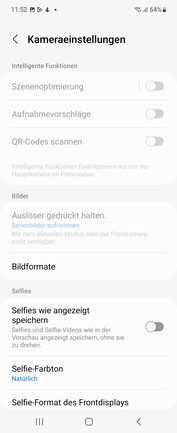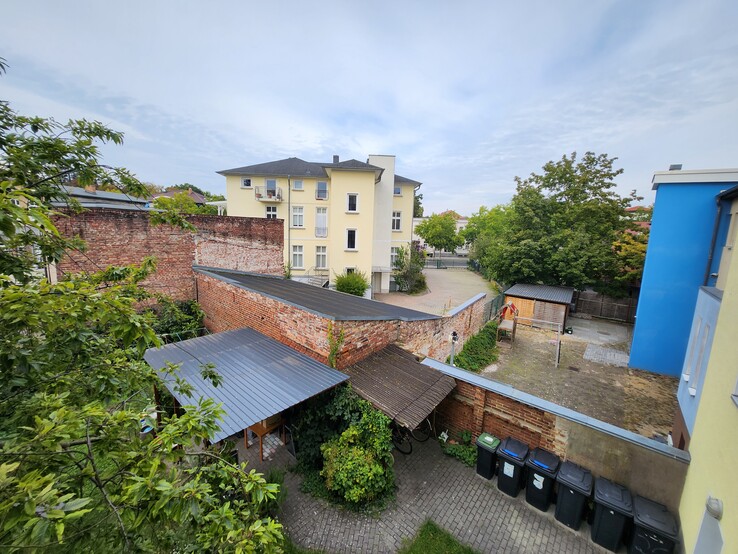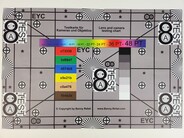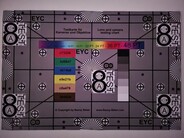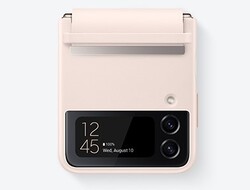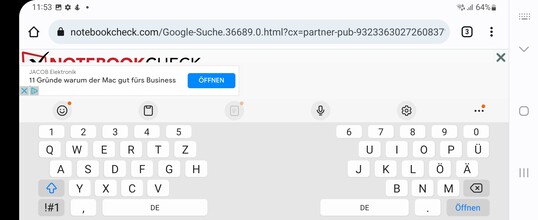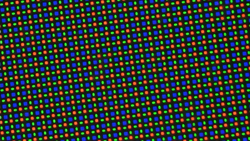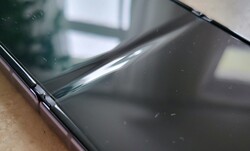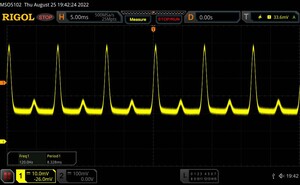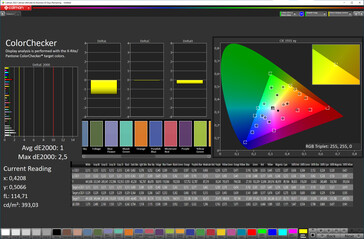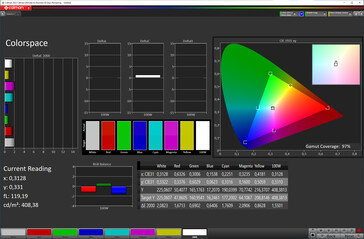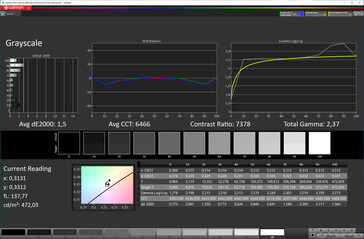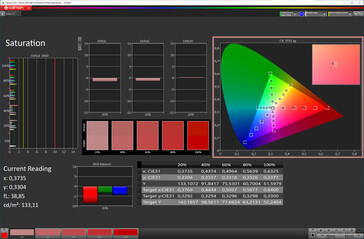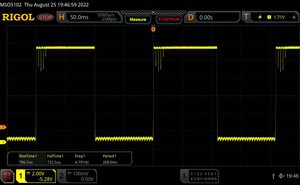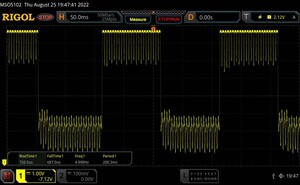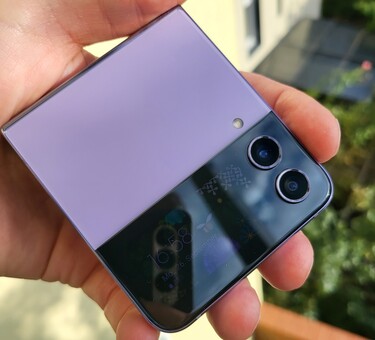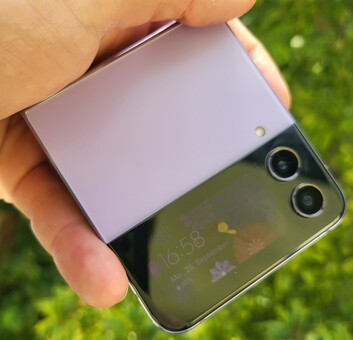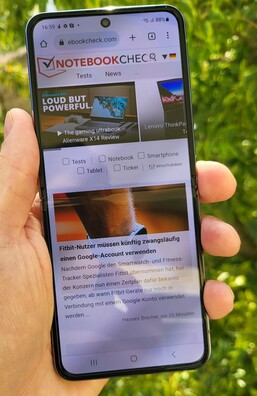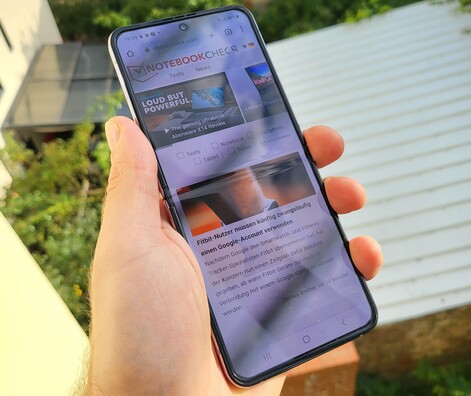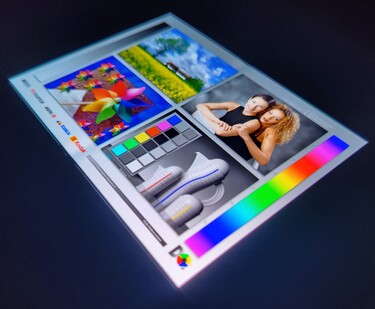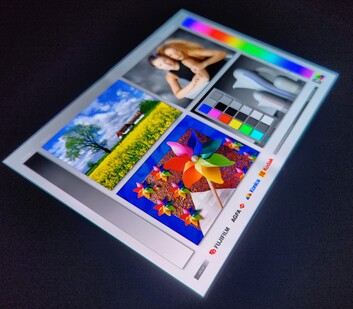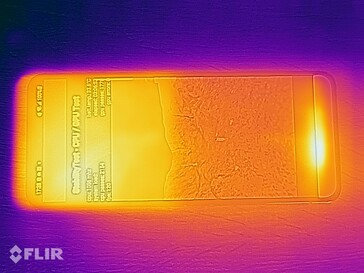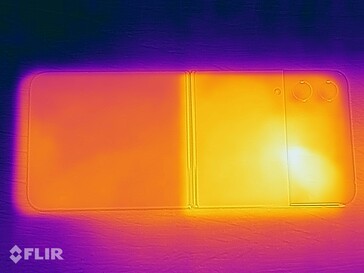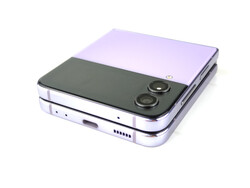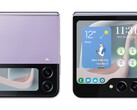Samsung Galaxy Z Flip4 5G Review - a compact foldable smartphone with lingering issues ↺
Like the Fold4, this year's Flip model relies on the Snapdragon 8+ Gen 1. The Flip4's main foldable display comes with a screen size of 6.7" and a 1080p resolution, with an additional 1.9" external screen.
The base model comes with 128 GB of internal memory and an MSRP of $999.99, while the top-of-the-line model with 512 GB comes in at $1,179.99. The Bespoke edition, which is only available at the Samsung Store, offers the opportunity to individualize the look of your Flip4 with different front and back panels, as well as different colored frames ($1,319.99).
Possible Competitors in Comparison
Rating | Date | Model | Weight | Drive | Size | Resolution | Price |
|---|---|---|---|---|---|---|---|
| 87.9 % v7 (old) | 10 / 2022 | Samsung Galaxy Z Flip4 5G SD 8+ Gen 1, Adreno 730 | 187 g | 128 GB UFS 3.1 Flash | 6.70" | 2640x1080 | |
| 86.3 % v7 (old) | 09 / 2021 | Samsung Galaxy Z Flip3 5G SD 888 5G, Adreno 660 | 183 g | 128 GB UFS 3.1 Flash | 6.70" | 2640x1080 | |
| 86.1 % v7 (old) | 03 / 2022 | Huawei P50 Pocket SD 888 4G, Adreno 660 | 190 g | 512 GB UFS 3.1 Flash | 6.90" | 2790x1188 | |
| 88.6 % v7 (old) | 09 / 2022 | Asus Zenfone 9 SD 8+ Gen 1, Adreno 730 | 169 g | 256 GB UFS 3.1 Flash | 5.90" | 2400x1080 | |
| 89.3 % v7 (old) | 05 / 2022 | Samsung Galaxy S22 Exynos 2200, Xclipse 920 | 167 g | 128 GB UFS 3.1 Flash | 6.10" | 2340x1080 |
Case - Samsung smartphone with a punch hole
The Galaxy Z Flip4 looks almost identical to its predecessor. According to Samsung, however, the hinges have been slimmed down and the joint between the screens straightened out. The very high-quality case, which is protected from water damage thanks to the IPX8 rating, is made of Corning Gorilla Glass Victus+ and from a particularly hard aluminum alloy called "Armor Aluminum". Fingerprints are hardly noticeable, thanks to the glass' matte finish.
The bezels around the foldable OLED display, which itself is protected by Samsung's own Ultra Thin Glass, seem to be somewhat narrower than on the Flip3. By the numbers, the screen accounts for nearly 86 percent of the front – that's more in line with a middle-range phone than a flagship device, however. The screen is also provided with a very resistant protective film. This screen protector feels quite good and cannot be removed.
Features - Galaxy Z Flip4 comes with UFS storage
The 3,700 mAh battery is charged via a USB 2.0 Type-C connector that can recognize external peripherals via USB-OTG. Wireless transmission to external monitors via Miracast is also supported.
There's no microSD card slot in the Flip4. However, the dual-SIM smartphone has an NFC chip for use with Samsung and Google Pay, as well as Bluetooth 5.2.
Software - Flip4 comes with Android 12
As usual, Samsung pairs the Android with its own user interface, OneUI Version 4. At the time of this review, the latter is OneUI 4.1.1 with the security patches from July 2022 still. In the best-case scenario, the Flip4 will receive updates up until Android 16, since the Galaxy Z family should enjoy up to four generations of OS updates and five years of security patches.
Communications and GNSS - 5G-capable Samsung smartphone
Data transfer rates within a home network are quite high with this Samsung foldable, but the WiFi module only communicates with our Asus ROG Rapture GT-AXE11000 reference router in the 2.4 and 5 GHz range. The Flip4 does not reach the high speeds that the Fold4 is (theoretically) capable of with its WiFi 6E.
Access to the LTE network, including various supported 4G frequencies, is guaranteed, and it's also possible to use the fast 5G spectrum. As with its predecessor, the fast mmWave standard available in Germany is unfortunately available with the Flip4.
| Networking | |
| iperf3 receive AXE11000 | |
| Asus Zenfone 9 | |
| Samsung Galaxy Z Flip4 5G | |
| Huawei P50 Pocket | |
| Samsung Galaxy S22 | |
| Average of class Smartphone (52 - 1721, n=179, last 2 years) | |
| iperf3 transmit AXE11000 | |
| Asus Zenfone 9 | |
| Samsung Galaxy Z Flip4 5G | |
| Huawei P50 Pocket | |
| Samsung Galaxy S22 | |
| Average of class Smartphone (49.8 - 1828, n=179, last 2 years) | |
| iperf3 transmit AXE11000 6GHz | |
| Asus Zenfone 9 | |
| Average of class Smartphone (508 - 1945, n=96, last 2 years) | |
| iperf3 receive AXE11000 6GHz | |
| Asus Zenfone 9 | |
| Average of class Smartphone (451 - 1870, n=96, last 2 years) | |
| iperf3 transmit AX12 | |
| Samsung Galaxy Z Flip3 5G | |
| iperf3 receive AX12 | |
| Samsung Galaxy Z Flip3 5G | |
We put the location tracking accuracy through a practical cycling test. Our short excursion was recorded in parallel with a Garmin Venu2 as a comparison device. The Flip4 occasionally shortens curves, although variations in the GPS results were still quite small. Unlike the Fold4, however, the Flip model only uses single-frequency GPS.
Telephony and call quality - Samsung phone with dual-SIMs
The call quality of the Flip4 is unobtrusive. Voices came through very clearly and were characterized as very clear at the other end of the line. An eSIM, WiFi calls, and VoLTE are also supported. Video calls through the built-in front camera via Skype worked without a problem in our test, and thanks to the Flex mode, without a stand.
Cameras - Galaxy Z Flip4 with dual cameras
Thanks to the foldable form factor of the Flip4, photos and videos can be taken using the main camera. The built-in 10 MP camera works very solidly for selfies as well, which however come out a bit pale and often somewhat overexposed.
The dual camera setup on the back comes with two sensors with a resolution of 12 MP each, although optical image stabilization is only available on the wide-angle lens. The new camera sensor of the Flip4 is derived from the Fold3's and is supposed to be up to 65 percent brighter than the one on the Galaxy Z Flip3 5G. Samsung's small foldable is still not an expert at dealing with low light, although photos and video in low-light situations are slightly better than those taken with its predecessor. Photos taken in daylight with the wide-angle lens looked great to us. Our analysis with the ColorChecker Passport also confirmed that the phone's camera has very reasonable color fidelity, with the exception of green tones.
The Flip4's 12 MP ultra-wide camera could display subjects a bit sharper and also offer more detail, in our opinion. Unfortunately, this Samsung phone lacks an 8K video option.
Image comparison
Choose a scene and navigate within the first image. One click changes the position on touchscreens. One click on the zoomed-in image opens the original in a new window. The first image shows the scaled photograph of the test device.
Main cameraMain cameraUltra wide-angleZoom 5xLow Light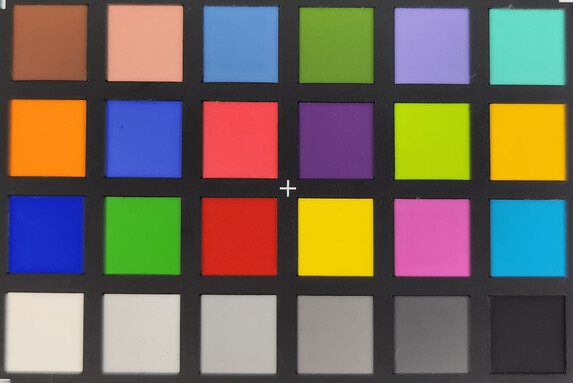
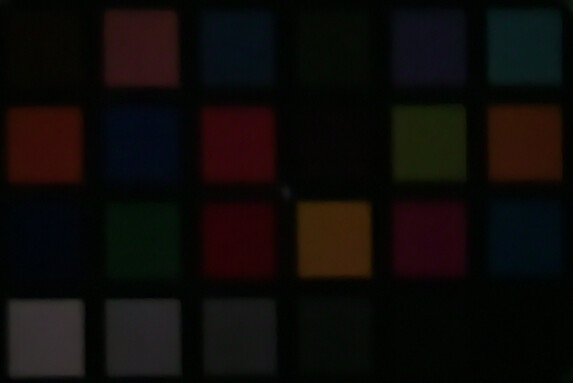
Accessories and warranty - Flip4 comes without a power adapter
Samsung doesn't provide a power adapter for its foldable smartphone, although it does provide a USB cable and information booklets.
The warranty lasts for 24 months from the purchase date. Samsung Care+ is once again included with purchase for one year, limited to one claim within the period.
Input devices and operation - Samsung smartphone with FaceUnlock
The Flip4 benefits from a crisp vibration motor, a high refresh rate of the 120 Hz main screen during operation, as well as from the 1.9" external display, which is similar to the Flip3's and runs at 60 Hz. The small front screen can also be used to take pictures with the main camera, which is improved thanks to the new Quick Shot function. Notifications can be viewed on the small screen, but replies can't be sent.
The fingerprint sensor built into the power button reacts quickly and recognizes registered fingerprints precisely. However, the positioning is way too high, leading to awkward grips when unlocking the Flip4. Biometric identification via face recognition when unlocking the phone is also made possible with the punch-hole camera.
Display - Galaxy Z Flip4 with AMOLED
The Flip4's foldable 6.7" LTPO-AMOLED display has a 22:9 aspect ratio, an adaptive refresh rate of 10 to 120 Hz, and a resolution of 2640 x 1080 pixels, meaning that the phone has a high pixel density of over 400 PPI. However, a look at the developer settings reveals that the screen only goes down to a minimum of 24 Hz. Since Fold4 is equally affected, we assume that this is caused by a built-in software restriction from Samsung.
The maximum screen brightness is good, with an average of 800 cd/m², but the Galaxy Z Flip3 achieves a slightly higher value in our measurement. The more realistic APL18 level is also slightly below its predecessor at 1,093 cd/m².
Like all OLEDs, this Samsung phone's screen also flickers. At the minimum brightness level, the display has a constant PWM of 120 Hz, above that the amplitude curve is at 240 Hz, but just as stable as with permanent DC dimming.
| |||||||||||||||||||||||||
Brightness Distribution: 97 %
Center on Battery: 795 cd/m²
Contrast: ∞:1 (Black: 0 cd/m²)
ΔE ColorChecker Calman: 1 | ∀{0.5-29.43 Ø4.77}
ΔE Greyscale Calman: 1.5 | ∀{0.09-98 Ø5}
97% sRGB (Calman 2D)
Gamma: 2.37
CCT: 6466 K
| Samsung Galaxy Z Flip4 5G Dynamic AMOLED , 2640x1080, 6.7" | Samsung Galaxy Z Flip3 5G AMOLED, 2640x1080, 6.7" | Huawei P50 Pocket Foldable OLED, 2790x1188, 6.9" | Asus Zenfone 9 AMOLED , 2400x1080, 5.9" | Samsung Galaxy S22 AMOLED, 2340x1080, 6.1" | |
|---|---|---|---|---|---|
| Screen | -18% | -8% | -30% | -22% | |
| Brightness middle (cd/m²) | 795 | 832 5% | 780 -2% | 793 0% | 853 7% |
| Brightness (cd/m²) | 800 | 842 5% | 768 -4% | 796 0% | 858 7% |
| Brightness Distribution (%) | 97 | 97 0% | 96 -1% | 97 0% | 96 -1% |
| Black Level * (cd/m²) | |||||
| Colorchecker dE 2000 * | 1 | 1.9 -90% | 1.1 -10% | 1.9 -90% | 1.9 -90% |
| Colorchecker dE 2000 max. * | 2.5 | 3.3 -32% | 3.1 -24% | 3.4 -36% | 3.2 -28% |
| Greyscale dE 2000 * | 1.5 | 1.4 7% | 1.6 -7% | 2.3 -53% | 1.9 -27% |
| Gamma | 2.37 93% | 2.1 105% | 2.23 99% | 2.26 97% | 2.07 106% |
| CCT | 6466 101% | 6453 101% | 6483 100% | 6860 95% | 6460 101% |
* ... smaller is better
Screen Flickering / PWM (Pulse-Width Modulation)
| Screen flickering / PWM detected | 120 Hz | ||
The display backlight flickers at 120 Hz (worst case, e.g., utilizing PWM) . The frequency of 120 Hz is very low, so the flickering may cause eyestrain and headaches after extended use. In comparison: 53 % of all tested devices do not use PWM to dim the display. If PWM was detected, an average of 8083 (minimum: 5 - maximum: 343500) Hz was measured. | |||
Series of measurements with a set zoom level and using different brightness settings
In our tests with the CalMAN software and using a spectrophotometer, the phone's OLED display appears to be very well calibrated - slight deviations can be seen in the magenta area, however. The DeltaE values are well within the ideal range (< 3) and the color temperature is spot-on at around 6,500K.
Display Response Times
| ↔ Response Time Black to White | ||
|---|---|---|
| 1.52 ms ... rise ↗ and fall ↘ combined | ↗ 0.7865 ms rise | |
| ↘ 0.7325 ms fall | ||
| The screen shows very fast response rates in our tests and should be very well suited for fast-paced gaming. In comparison, all tested devices range from 0.1 (minimum) to 240 (maximum) ms. » 8 % of all devices are better. This means that the measured response time is better than the average of all tested devices (20.2 ms). | ||
| ↔ Response Time 50% Grey to 80% Grey | ||
| 1.41 ms ... rise ↗ and fall ↘ combined | ↗ 0.7205 ms rise | |
| ↘ 0.687 ms fall | ||
| The screen shows very fast response rates in our tests and should be very well suited for fast-paced gaming. In comparison, all tested devices range from 0.165 (minimum) to 636 (maximum) ms. » 6 % of all devices are better. This means that the measured response time is better than the average of all tested devices (31.6 ms). | ||
Daylight does not pose any problems for the Flip4 - at least when it comes to the main display. Disturbing reflections can be seen on the screen protector, but reflections only limit readability slightly and in direct sunlight. The small outer panel, on the other hand, is less easy to read outdoors; we had to look for shade to read the outer panel during our test or to actively shade the panel with our other hand.
Thanks to the built-in OLED technology, the viewing angles are very good for both the main and outer screens.
Performance - Flip4 with Qualcomm SoC
In everyday use, the Flip4 runs very smoothly and almost without hiccups thanks to the Snapdragon 8+ Gen 1. System performance is excellent, and app loading times are very short. The Qualcomm SoC really shows off its great performance in our benchmark test, but the Samsung phone performs slightly below the Asus Zenfone 9.
| CrossMark - Overall | |
| Average of class Smartphone (187 - 2722, n=122, last 2 years) | |
| Asus Zenfone 9 | |
| Samsung Galaxy Z Flip4 5G | |
| Average Qualcomm Snapdragon 8+ Gen 1 (749 - 1178, n=23) | |
| Samsung Galaxy S22 | |
| UL Procyon AI Inference for Android - Overall Score NNAPI | |
| Samsung Galaxy Z Flip4 5G | |
| Asus Zenfone 9 | |
| Average Qualcomm Snapdragon 8+ Gen 1 (3291 - 84787, n=21) | |
| Average of class Smartphone (3769 - 81594, n=133, last 2 years) | |
| AImark - Score v2.x | |
| Asus Zenfone 9 | |
| Samsung Galaxy Z Flip4 5G | |
| Samsung Galaxy S22 | |
| Average Qualcomm Snapdragon 8+ Gen 1 (1043 - 7865, n=11) | |
| 3DMark | |
| Wild Life Extreme Unlimited | |
| Samsung Galaxy Z Flip4 5G | |
| Asus Zenfone 9 | |
| Samsung Galaxy S22 | |
| Huawei P50 Pocket | |
| Samsung Galaxy Z Flip3 5G | |
| Wild Life Extreme | |
| Samsung Galaxy Z Flip4 5G | |
| Asus Zenfone 9 | |
| Samsung Galaxy S22 | |
| Huawei P50 Pocket | |
| Samsung Galaxy Z Flip3 5G | |
| Wild Life Unlimited Score | |
| Samsung Galaxy Z Flip4 5G | |
| Asus Zenfone 9 | |
| Samsung Galaxy S22 | |
| Huawei P50 Pocket | |
| Samsung Galaxy Z Flip3 5G | |
| Wild Life Score | |
| Samsung Galaxy S22 | |
| Huawei P50 Pocket | |
| Samsung Galaxy Z Flip3 5G | |
| GFXBench (DX / GLBenchmark) 2.7 | |
| T-Rex Onscreen | |
| Asus Zenfone 9 | |
| Samsung Galaxy S22 | |
| Samsung Galaxy Z Flip4 5G | |
| Samsung Galaxy Z Flip3 5G | |
| Huawei P50 Pocket | |
| 1920x1080 T-Rex Offscreen | |
| Asus Zenfone 9 | |
| Samsung Galaxy Z Flip4 5G | |
| Samsung Galaxy S22 | |
| Huawei P50 Pocket | |
| Samsung Galaxy Z Flip3 5G | |
| GFXBench 3.0 | |
| on screen Manhattan Onscreen OGL | |
| Samsung Galaxy S22 | |
| Asus Zenfone 9 | |
| Samsung Galaxy Z Flip4 5G | |
| Samsung Galaxy Z Flip3 5G | |
| Huawei P50 Pocket | |
| 1920x1080 1080p Manhattan Offscreen | |
| Samsung Galaxy S22 | |
| Asus Zenfone 9 | |
| Samsung Galaxy Z Flip4 5G | |
| Huawei P50 Pocket | |
| Samsung Galaxy Z Flip3 5G | |
| GFXBench 3.1 | |
| on screen Manhattan ES 3.1 Onscreen | |
| Samsung Galaxy S22 | |
| Asus Zenfone 9 | |
| Samsung Galaxy Z Flip4 5G | |
| Samsung Galaxy Z Flip3 5G | |
| Huawei P50 Pocket | |
| 1920x1080 Manhattan ES 3.1 Offscreen | |
| Samsung Galaxy S22 | |
| Asus Zenfone 9 | |
| Samsung Galaxy Z Flip4 5G | |
| Samsung Galaxy Z Flip3 5G | |
| Huawei P50 Pocket | |
| GFXBench | |
| on screen Car Chase Onscreen | |
| Asus Zenfone 9 | |
| Samsung Galaxy S22 | |
| Samsung Galaxy Z Flip4 5G | |
| Samsung Galaxy Z Flip3 5G | |
| Huawei P50 Pocket | |
| 1920x1080 Car Chase Offscreen | |
| Asus Zenfone 9 | |
| Samsung Galaxy S22 | |
| Samsung Galaxy Z Flip4 5G | |
| Samsung Galaxy Z Flip3 5G | |
| Huawei P50 Pocket | |
| on screen Aztec Ruins High Tier Onscreen | |
| Asus Zenfone 9 | |
| Samsung Galaxy Z Flip4 5G | |
| Samsung Galaxy S22 | |
| Samsung Galaxy Z Flip3 5G | |
| Huawei P50 Pocket | |
| 2560x1440 Aztec Ruins High Tier Offscreen | |
| Asus Zenfone 9 | |
| Samsung Galaxy Z Flip4 5G | |
| Samsung Galaxy S22 | |
| Huawei P50 Pocket | |
| Samsung Galaxy Z Flip3 5G | |
| on screen Aztec Ruins Normal Tier Onscreen | |
| Asus Zenfone 9 | |
| Samsung Galaxy S22 | |
| Samsung Galaxy Z Flip4 5G | |
| Samsung Galaxy Z Flip3 5G | |
| Huawei P50 Pocket | |
| 1920x1080 Aztec Ruins Normal Tier Offscreen | |
| Asus Zenfone 9 | |
| Samsung Galaxy Z Flip4 5G | |
| Samsung Galaxy S22 | |
| Huawei P50 Pocket | |
| Samsung Galaxy Z Flip3 5G | |
| Jetstream 2 - 2.0 Total Score | |
| Average of class Smartphone (23.8 - 387, n=148, last 2 years) | |
| Samsung Galaxy Z Flip4 5G (Chrome 105) | |
| Asus Zenfone 9 (Chrome 104) | |
| Average Qualcomm Snapdragon 8+ Gen 1 (76.2 - 204, n=23) | |
| Samsung Galaxy S22 (Chrome 100.0.4896.79) | |
| Speedometer 2.0 - Result 2.0 | |
| Average of class Smartphone (15.2 - 643, n=120, last 2 years) | |
| Average Qualcomm Snapdragon 8+ Gen 1 (69.1 - 196, n=18) | |
| Samsung Galaxy S22 (Chrome 100.0.4896.79) | |
| Asus Zenfone 9 | |
| WebXPRT 4 - Overall | |
| Average of class Smartphone (27 - 306, n=144, last 2 years) | |
| Asus Zenfone 9 (Chrome 104) | |
| Samsung Galaxy Z Flip4 5G (chrome 105) | |
| Average Qualcomm Snapdragon 8+ Gen 1 (69 - 159, n=21) | |
| WebXPRT 3 - Overall | |
| Average of class Smartphone (38 - 380, n=30, last 2 years) | |
| Asus Zenfone 9 (Chrome 104) | |
| Average Qualcomm Snapdragon 8+ Gen 1 (106 - 224, n=14) | |
| Samsung Galaxy Z Flip3 5G (Chrome 93) | |
| Samsung Galaxy S22 (Chrome 100.0.4896.79) | |
| Huawei P50 Pocket (Huawei Browser 11.1) | |
| Octane V2 - Total Score | |
| Asus Zenfone 9 (Chrome 104) | |
| Samsung Galaxy Z Flip4 5G (Chrome 105) | |
| Average of class Smartphone (2228 - 126661, n=195, last 2 years) | |
| Average Qualcomm Snapdragon 8+ Gen 1 (17622 - 61536, n=24) | |
| Samsung Galaxy S22 (Chrome 100.0.4896.79) | |
| Samsung Galaxy Z Flip3 5G (Chrome 93) | |
| Huawei P50 Pocket (Huawei Browser 11.1) | |
| Mozilla Kraken 1.1 - Total | |
| Huawei P50 Pocket (Huawei Browser 11.1) | |
| Samsung Galaxy S22 (Chrome 100.0.4896.79) | |
| Average of class Smartphone (257 - 28190, n=155, last 2 years) | |
| Average Qualcomm Snapdragon 8+ Gen 1 (665 - 1707, n=22) | |
| Samsung Galaxy Z Flip3 5G (Chrome 93) | |
| Samsung Galaxy Z Flip4 5G (Chrome 105) | |
| Asus Zenfone 9 (Chrome 104) | |
* ... smaller is better
| Samsung Galaxy Z Flip4 5G | Samsung Galaxy Z Flip3 5G | Huawei P50 Pocket | Asus Zenfone 9 | Samsung Galaxy S22 | Average 128 GB UFS 3.1 Flash | Average of class Smartphone | |
|---|---|---|---|---|---|---|---|
| AndroBench 3-5 | -8% | -1% | 41% | -3% | -11% | 42% | |
| Sequential Read 256KB (MB/s) | 1598.77 | 1620 1% | 1839 15% | 1986.97 24% | 1486 -7% | 1575 ? -1% | 2240 ? 40% |
| Sequential Write 256KB (MB/s) | 987.09 | 750 -24% | 575 -42% | 1776.21 80% | 993 1% | 780 ? -21% | 1877 ? 90% |
| Random Read 4KB (MB/s) | 308.23 | 276.6 -10% | 263.5 -15% | 298.46 -3% | 273 -11% | 244 ? -21% | 298 ? -3% |
| Random Write 4KB (MB/s) | 245.94 | 250.6 2% | 342.1 39% | 398.39 62% | 257.6 5% | 244 ? -1% | 345 ? 40% |
Emissions - Samsung phone stays cool
Temperature
The Flip4's case only warms up slightly under load. Nevertheless, the phone shows a strong reduction in performance during the 3DMark stress tests. We did not observe any overheating of the system in the test, although we did notice a throttling of over 50 percent.
(+) The maximum temperature on the upper side is 33.4 °C / 92 F, compared to the average of 35.2 °C / 95 F, ranging from 21.9 to 247 °C for the class Smartphone.
(+) The bottom heats up to a maximum of 32.7 °C / 91 F, compared to the average of 34 °C / 93 F
(+) In idle usage, the average temperature for the upper side is 25.4 °C / 78 F, compared to the device average of 32.9 °C / 91 F.
3DMark Wild Life Stress Test
| 3DMark | |
| Wild Life Stress Test Stability | |
| Samsung Galaxy Z Flip3 5G | |
| Huawei P50 Pocket | |
| Samsung Galaxy S22 | |
| Asus Zenfone 9 | |
| Samsung Galaxy Z Flip4 5G | |
| Wild Life Extreme Stress Test | |
| Samsung Galaxy Z Flip3 5G | |
| Huawei P50 Pocket | |
| Samsung Galaxy Z Flip4 5G | |
| Samsung Galaxy S22 | |
| Asus Zenfone 9 | |
Speakers
Not much has changed in the speakers when compared to its predecessor. The two speakers are very good when compared to the thin design of the Flip4, although the highs drop a bit. The mids, however, are quite linear in the audio spectrum.
For those who want wireless sound, the Bluetooth codecs SBC, AAC, aptX, and LDAC are available. A wired headphone solution can be implemented via the USB-C port.
Samsung Galaxy Z Flip4 5G audio analysis
(+) | speakers can play relatively loud (86.3 dB)
Bass 100 - 315 Hz
(-) | nearly no bass - on average 22.7% lower than median
(±) | linearity of bass is average (11.6% delta to prev. frequency)
Mids 400 - 2000 Hz
(+) | balanced mids - only 3.7% away from median
(+) | mids are linear (3.4% delta to prev. frequency)
Highs 2 - 16 kHz
(±) | higher highs - on average 6.1% higher than median
(+) | highs are linear (2.5% delta to prev. frequency)
Overall 100 - 16.000 Hz
(±) | linearity of overall sound is average (17.4% difference to median)
Compared to same class
» 12% of all tested devices in this class were better, 8% similar, 80% worse
» The best had a delta of 11%, average was 35%, worst was 134%
Compared to all devices tested
» 32% of all tested devices were better, 8% similar, 59% worse
» The best had a delta of 4%, average was 24%, worst was 134%
Samsung Galaxy Z Flip3 5G audio analysis
(+) | speakers can play relatively loud (88.6 dB)
Bass 100 - 315 Hz
(-) | nearly no bass - on average 27.7% lower than median
(±) | linearity of bass is average (9.3% delta to prev. frequency)
Mids 400 - 2000 Hz
(+) | balanced mids - only 3.6% away from median
(+) | mids are linear (4% delta to prev. frequency)
Highs 2 - 16 kHz
(±) | higher highs - on average 5.5% higher than median
(+) | highs are linear (3.6% delta to prev. frequency)
Overall 100 - 16.000 Hz
(±) | linearity of overall sound is average (18.3% difference to median)
Compared to same class
» 18% of all tested devices in this class were better, 9% similar, 73% worse
» The best had a delta of 11%, average was 35%, worst was 134%
Compared to all devices tested
» 39% of all tested devices were better, 8% similar, 53% worse
» The best had a delta of 4%, average was 24%, worst was 134%
Battery life - Samsung Galaxy Z Flip4 5G Smartphone
Power consumption
With 3,700 mAh, the Flip4 has a slightly larger battery than its predecessor. The battery can be charged both wirelessly and wired, although not particularly quickly in either case. All the same, the power has been increased to 25 watts, which is limited to 10 watts for inductive charging. Wireless PowerShare at 5 watts is also available.
The idle power consumption is very low; under load, power consumption is on the level of a Zenfone 9 with a Snapdragon 8+ Gen1. Similar to the Fold4, the Flip4 shows a sharp drop in power consumption in GFXBench, (probably) due to throttling.
| Off / Standby | |
| Idle | |
| Load |
|
Key:
min: | |
| Samsung Galaxy Z Flip4 5G 3700 mAh | Samsung Galaxy Z Flip3 5G 3300 mAh | Huawei P50 Pocket 4000 mAh | Asus Zenfone 9 4300 mAh | Samsung Galaxy S22 3700 mAh | Average Qualcomm Snapdragon 8+ Gen 1 | Average of class Smartphone | |
|---|---|---|---|---|---|---|---|
| Power Consumption | -2% | -97% | -39% | -56% | -96% | -86% | |
| Idle Minimum * (Watt) | 0.56 | 0.46 18% | 1.33 -138% | 1.01 -80% | 0.69 -23% | 1.006 ? -80% | 0.847 ? -51% |
| Idle Average * (Watt) | 0.71 | 0.74 -4% | 1.77 -149% | 1.1 -55% | 1.19 -68% | 1.834 ? -158% | 1.446 ? -104% |
| Idle Maximum * (Watt) | 0.79 | 0.78 1% | 1.89 -139% | 1.17 -48% | 1.26 -59% | 1.984 ? -151% | 1.63 ? -106% |
| Load Average * (Watt) | 3.59 | 4.73 -32% | 4.25 -18% | 3.3 8% | 6.97 -94% | 5.68 ? -58% | 6.95 ? -94% |
| Load Maximum * (Watt) | 6.45 | 5.89 9% | 9.19 -42% | 7.89 -22% | 8.85 -37% | 8.44 ? -31% | 11.3 ? -75% |
* ... smaller is better
Power consumption: Geekbench (150 cd/m²)
Power consumption: GFXBench (150 cd/m²)
Battery life
During our practical WiFi test with an adjusted display brightness of 150 cd/m² battery life was very different. While the Flip4 has almost the same endurance (8 hours, 56 minutes) as a Flip3 with Samsung's own browser, we measured a significantly better 11 hours with Chrome. These runtimes may vary due to differences in the adaptive refresh rate, but we can't see any differences in the Hz values in the browser script.
| Samsung Galaxy Z Flip4 5G 3700 mAh | Samsung Galaxy Z Flip3 5G 3300 mAh | Huawei P50 Pocket 4000 mAh | Asus Zenfone 9 4300 mAh | Samsung Galaxy S22 3700 mAh | |
|---|---|---|---|---|---|
| Battery runtime | |||||
| WiFi v1.3 (h) | 11 | 9 -18% | 8 -27% | 13.8 25% | 11.3 3% |
Pros
Cons
Verdict
Because of its small profile when folded, the Galaxy Z Flip4 is a very interesting alternative to smaller standard phones, like the Asus Zenfone 9 or Samsung's own Galaxy S22. The case leaves a great impression, and the performance is, thanks to the Snapdragon 8+ Gen 1, as attractive as both the high-quality finishing and the beautiful foldable OLED display. What was a bit disappointing, however, was the lower brightness relative to the Flip3. We would have hoped for a similar upgrade to the Fold4 in this respect.
Anyone who really enjoys the folding mechanism should take a closer look at this Samsung foldable, given the Flip4's very competitive pricing.
We have to be critical, once again, of Samsung's placement of the buttons, which are still too high - even someone with big hands will find it impossible to reach the fingerprint reader with a normal grip, which becomes a daily frustration. The slow USB connection and the limitations when compared to the Fold series (no pen use supported, no dual-frequency GPS, no WiFi 6E, and no UWB) are also noticeable.
The biggest weakness of its predecessor, the limited battery life, appears to have been resolved by Samsung - at least in part. Power users will still not be able to make it through the day on a single charge, which is particularly problematic given the slow fast-charge technology.
Price and Availability
Samsung Galaxy Z Flip4 5G
- 09/30/2022 v7 (old)
Marcus Herbrich



